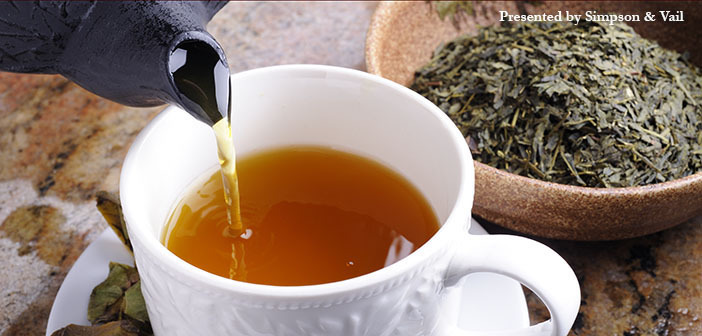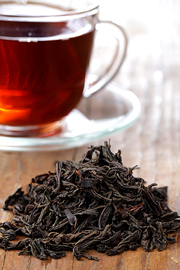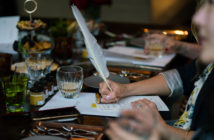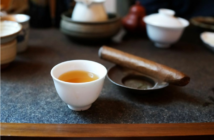Whether you’re a devotee of tea bags or a coffee addict looking for an alternate beverage, the fabulous (and ancient) world of loose leaf tea awaits your discovery!
Loose leaf tea is no more complicated to brew and enjoy than bagged tea—and, as many would attest, it offers depths of flavor that the packaged version simply can’t match. Drinking loose leaf tea immerses you in thousands of years of wide-ranging history: There’s some fascinating time and armchair travel going on with each sip.
Here’s a quick primer on selecting and brewing loose leaf tea. Cheers!
How to Select
There’s a whole universe of flavors available across the different tea classes, from grassy-tasting greens to smoky blacks and earthy pu-erhs, but there are only five basic types: white, green, oolong, black and pu-erh. The way a specific tea is processed—for example, how much oxidization it’s permitted to undergo—determines how it’s categorized and how it tastes.
- If you’re lucky enough to have a tea vendor who’ll curate a tasting for you (or a tea-fanatic friend eager to do the same) that’s a great way to learn your personal palate. Otherwise, just dive in and try out a few different kinds of teas to find out which appeal to you most.
- A great advantage of loose leaf over bagged tea is your ability to see and smell the product before purchasing it. Generally, it’s better to buy more intact-looking leaves; a lot of crushed bits can indicate rough handling, excessive processing, and/or stale tea. Let your nose gauge the quality: Sniff for freshness and richness.
- If you’ve never had a particular kind of tea before, or if you’re buying it from a new source, it’s a good idea to purchase just a small amount at first. This is kindlier on your pocketbook, and also wards against having a stockpile of rarely drunk tea that’s becoming more flavorless by the day.
How to Brew
Besides its processing and freshness, the flavor of a given tea depends greatly on the manner in which it’s steeped. Some of the most important steeping factors include:
- The ratio of leaves to water. The recommended amount of loose tea is one measuring teaspoon per cup water, making many loose teas less expensive than bagged. Using more tea leaves will yield a stronger cup, but make sure that you have enough room in your infuser for the water to circulate around the leaves. The wet leaves are more than double the size of the dry leaf.
- The temperature of the water. The brewing instructions printed on most tea containers will include the recommended temperature. Often lightly oxidized teas like greens and whites are steeped in cooler water (say, 180 or 185 degrees Fahrenheit) while boiling water is typically used for well-oxidized oolongs, blacks, and pu-erhs.
- The steeping time. Longer steeps make for a stronger-flavored, more caffeinated cup of tea. Again, brewing times are generally recommended by your tea purveyor and vary depending on the type of tea. With multiple infusions, you typically increase steeping times to account for diminishing strength.
Ultimately, though, the way you brew your tea comes down to personal preference. Experiment with different amounts, temperatures, and steeping times to sample the impacts on flavor—and go with whatever method results in the tastiest tea for you!
Brewing Vessels
You don’t need a bunch of fancy equipment to enjoy loose leaf tea. Mesh strainers and infusers are readily available; to use them, simply put the leaves into the strainer, steep and remove. Teapots and mugs with removable mesh baskets make the process easier. Or try paper filters; think of them as “fill your own” tea bags. And don’t forget to check out the numerous tea infuser travel mugs that brew and store your tea while you’re on the run. Whatever vessel you choose, brewing loose leaf tea is as easy as 1-2-3!
Once you’ve tried loose leaf tea, it’s hard to go back. You’ll likely find yourself at the pinnacle of a lifelong love affair—and an endless taste adventure.
Super Simple Loose Leaf Tea in a Snap
- 1 teaspoon loose leaf black tea
- 6 ounces high-quality water
- Optional: sweetener, lemon, or milk
Directions:
- Spoon the loose leaf tea into a tea strainer or paper filter and place in a cup.
- Boil water and pour over tea in cup.
- Steep for 3 minutes.
- Remove strainer or filter from tea.
- Add sweetener, lemon or milk as desired.
Did you know:
Pu-erh is a black tea that is fermented. Two styles of pu-erh are available: cakes or bricks and loose leaf tea and are comprised of either oxidized or un-oxidized leaves.





